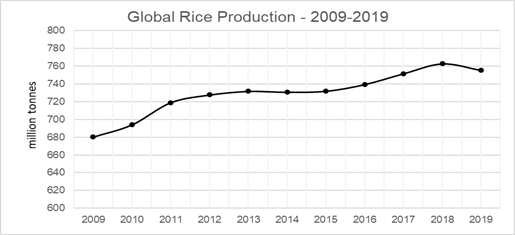IELTS Academic Writing Task 1 Sample 7
Global Rice Production
Below are two graphs depicting trends in rice (paddy) production in the world. Summarise the two and write a report based on your observation. (At least 150 words)


Data Source: http://www.fao.org/faostat/en/#data/QC/visualize
-
Sample Answer |
|---|
The ten-year data for Global Rice Production between 2009 and 2019 shows an increase of approximately 75 million tonnes. Production was at 680 million tonnes during 2009, which rose to 755 million tonnes by 2019. However, the growth has not been on a steady curve and there have been periodic ups and downs during the course of these years. The period between 2009 and 2011 witnessed the steepest growth as production grew from 680 to 720 million tonnes. The output plateaued between 2011 and 2016 as the world added only an additional 20 million tonnes to reach 740 million tonnes. The momentum picked up slightly thereafter and within the next two years, between 2016 and 2018, total yield crossed the 760 million tonnes mark. However, this was not sustained, and by 2019, it fell to 755 million tonnes. Rice production is dominated by Asian countries. Among the Top Ten Global Producers in terms of Ten-Year Average Paddy Production, China leads the world with about 205 million tonnes of output between 2009 to 2019. This is followed by India with 159 million. Indonesia and Bangladesh are ranked at three and four with 59 and 51 million tonnes, respectively. Average ten-year production for Vietnam, Thailand and Myanmar totaled about 100 million tonnes jointly and they occupy the fifth, sixth and seventh position, respectively. Among the bottom three in the list, Philippines produces 18 million tonnes, Brazil at number nine produces 12, and Japan’s yield stands at 11 million tonnes. A comparative look at the two graphs shows that the combined average ten-year output for the top ten producers is more than a whopping 80 percent of the total global output. |
-
Analysis |
|---|
COHERENCE AND COHESION
|
GRAMMAR
*A note on ‘between’ versus ‘from’: When talking about the passage of time between two dates (as in this extract), be careful how you use the associated conjunctions or prepositions. If you want to use ‘between’, you should use the conjunction ‘and' between the two dates; i.e. between 2016 and 2018. If you choose to use ‘from’, you will need the preposition ‘to’; i.e from 2016 to 2018. |
LEXICAL RESOURCE plateaued - a clever way to say that something ‘levelled' or ‘evened’ out. Used when figures remain the same or at a relatively steady level for a distinct period. whopping - a synonym for ‘(very) big’. Click here for our Synonyms for the word ‘big’. |